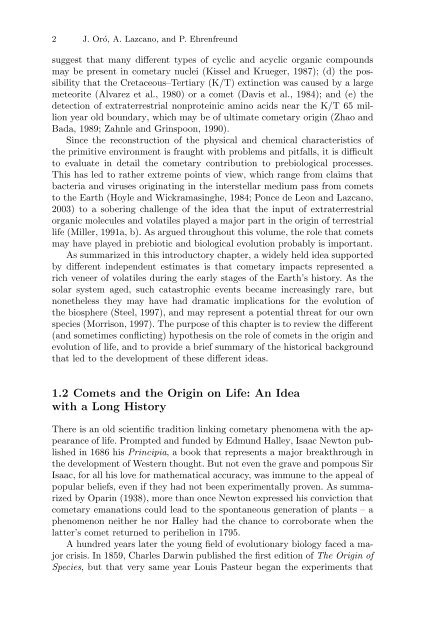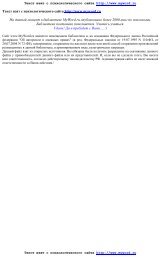Comets and the Origin and Evolution of Life
Comets and the Origin and Evolution of Life
Comets and the Origin and Evolution of Life
Create successful ePaper yourself
Turn your PDF publications into a flip-book with our unique Google optimized e-Paper software.
2 J. Oró, A. Lazcano, <strong>and</strong> P. Ehrenfreund<br />
suggest that many different types <strong>of</strong> cyclic <strong>and</strong> acyclic organic compounds<br />
may be present in cometary nuclei (Kissel <strong>and</strong> Krueger, 1987); (d) <strong>the</strong> possibility<br />
that <strong>the</strong> Cretaceous–Tertiary (K/T) extinction was caused by a large<br />
meteorite (Alvarez et al., 1980) or a comet (Davis et al., 1984); <strong>and</strong> (e) <strong>the</strong><br />
detection <strong>of</strong> extraterrestrial nonproteinic amino acids near <strong>the</strong> K/T 65 million<br />
year old boundary, which may be <strong>of</strong> ultimate cometary origin (Zhao <strong>and</strong><br />
Bada, 1989; Zahnle <strong>and</strong> Grinspoon, 1990).<br />
Since <strong>the</strong> reconstruction <strong>of</strong> <strong>the</strong> physical <strong>and</strong> chemical characteristics <strong>of</strong><br />
<strong>the</strong> primitive environment is fraught with problems <strong>and</strong> pitfalls, it is difficult<br />
to evaluate in detail <strong>the</strong> cometary contribution to prebiological processes.<br />
This has led to ra<strong>the</strong>r extreme points <strong>of</strong> view, which range from claims that<br />
bacteria <strong>and</strong> viruses originating in <strong>the</strong> interstellar medium pass from comets<br />
to <strong>the</strong> Earth (Hoyle <strong>and</strong> Wickramasinghe, 1984; Ponce de Leon <strong>and</strong> Lazcano,<br />
2003) to a sobering challenge <strong>of</strong> <strong>the</strong> idea that <strong>the</strong> input <strong>of</strong> extraterrestrial<br />
organic molecules <strong>and</strong> volatiles played a major part in <strong>the</strong> origin <strong>of</strong> terrestrial<br />
life (Miller, 1991a, b). As argued throughout this volume, <strong>the</strong> role that comets<br />
may have played in prebiotic <strong>and</strong> biological evolution probably is important.<br />
As summarized in this introductory chapter, a widely held idea supported<br />
by different independent estimates is that cometary impacts represented a<br />
rich veneer <strong>of</strong> volatiles during <strong>the</strong> early stages <strong>of</strong> <strong>the</strong> Earth’s history. As <strong>the</strong><br />
solar system aged, such catastrophic events became increasingly rare, but<br />
none<strong>the</strong>less <strong>the</strong>y may have had dramatic implications for <strong>the</strong> evolution <strong>of</strong><br />
<strong>the</strong> biosphere (Steel, 1997), <strong>and</strong> may represent a potential threat for our own<br />
species (Morrison, 1997). The purpose <strong>of</strong> this chapter is to review <strong>the</strong> different<br />
(<strong>and</strong> sometimes conflicting) hypo<strong>the</strong>sis on <strong>the</strong> role <strong>of</strong> comets in <strong>the</strong> origin <strong>and</strong><br />
evolution <strong>of</strong> life, <strong>and</strong> to provide a brief summary <strong>of</strong> <strong>the</strong> historical background<br />
that led to <strong>the</strong> development <strong>of</strong> <strong>the</strong>se different ideas.<br />
1.2 <strong>Comets</strong> <strong>and</strong> <strong>the</strong> <strong>Origin</strong> on <strong>Life</strong>: An Idea<br />
with a Long History<br />
There is an old scientific tradition linking cometary phenomena with <strong>the</strong> appearance<br />
<strong>of</strong> life. Prompted <strong>and</strong> funded by Edmund Halley, Isaac Newton published<br />
in 1686 his Principia, a book that represents a major breakthrough in<br />
<strong>the</strong> development <strong>of</strong> Western thought. But not even <strong>the</strong> grave <strong>and</strong> pompous Sir<br />
Isaac, for all his love for ma<strong>the</strong>matical accuracy, was immune to <strong>the</strong> appeal <strong>of</strong><br />
popular beliefs, even if <strong>the</strong>y had not been experimentally proven. As summarized<br />
by Oparin (1938), more than once Newton expressed his conviction that<br />
cometary emanations could lead to <strong>the</strong> spontaneous generation <strong>of</strong> plants – a<br />
phenomenon nei<strong>the</strong>r he nor Halley had <strong>the</strong> chance to corroborate when <strong>the</strong><br />
latter’s comet returned to perihelion in 1795.<br />
A hundred years later <strong>the</strong> young field <strong>of</strong> evolutionary biology faced a major<br />
crisis. In 1859, Charles Darwin published <strong>the</strong> first edition <strong>of</strong> The <strong>Origin</strong> <strong>of</strong><br />
Species, but that very same year Louis Pasteur began <strong>the</strong> experiments that



